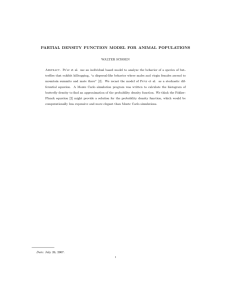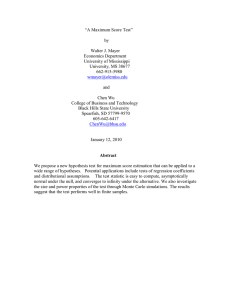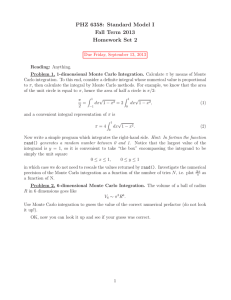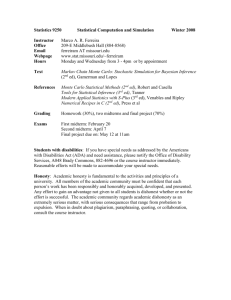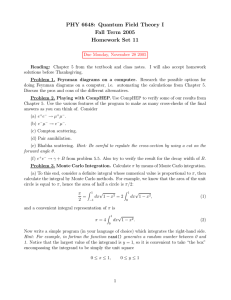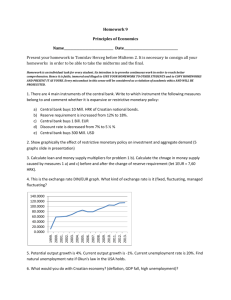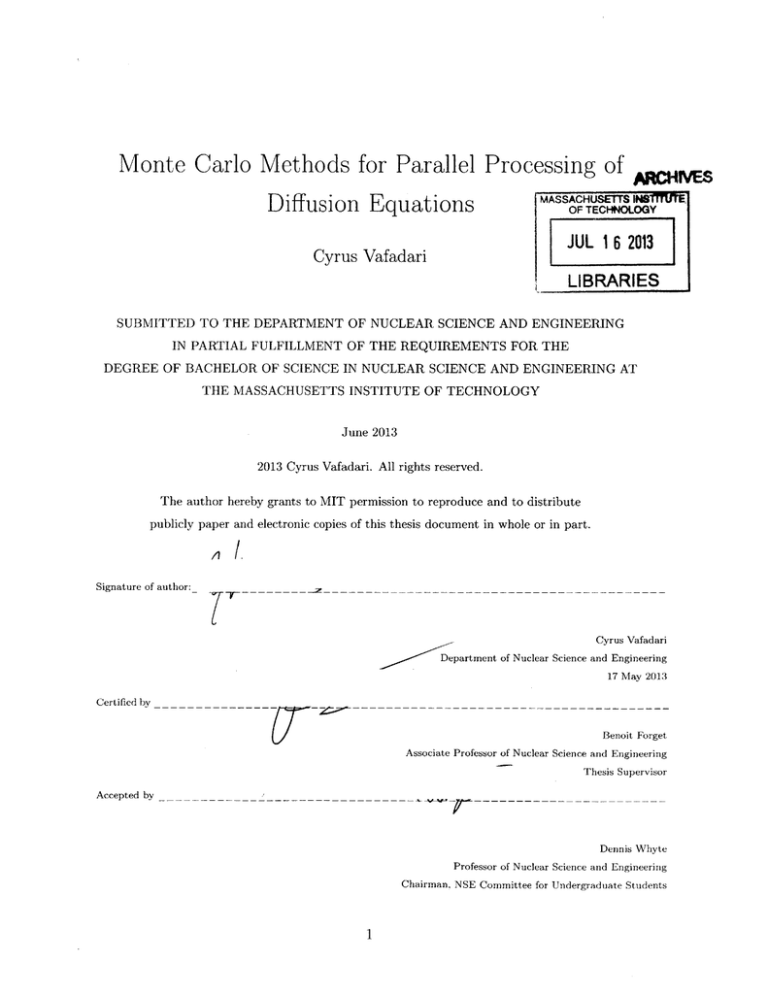
Monte Carlo Methods for Parallel Processing of
Diffusion Equations
OF TECHNOLOGY
JUL 16 2013
Cyrus Vafadari
LIBRARIES
SUBMITTED TO THE DEPARTMENT OF NUCLEAR SCIENCE AND ENGINEERING
IN PARTIAL FULFILLMENT OF THE REQUIREMENTS FOR THE
DEGREE OF BACHELOR OF SCIENCE IN NUCLEAR SCIENCE AND ENGINEERING AT
THE MASSACHUSETTS INSTITUTE OF TECHNOLOGY
June 2013
2013 Cyrus Vafadari. All rights reserved.
The author hereby grants to MIT permission to reproduce and to distribute
publicly paper and electronic copies of this thesis document in whole or in part.
Z /.
Signature of author:
Cyrus Vafadari
Department of Nuclear Science and Engineering
17 May 2013
Certified by
Benoit Forget
Associate Professor of Nuclear Science and Engineering
Thesis Supervisor
Accepted by----------
--------------------
Dennis Whyte
Professor of Nuclear Science and Engineering
Chairman, NSE Committee for Undergraduate Students
1
Mu
Libraries
Document
Services
Room 14-0551
77 Massachusetts Avenue
Cambridge, MA 02139
Ph: 617.253.2800
Email: docs@mit.edu
http://Ilibraries.mit.edu/docs
DISCLAIMER OF QUALITY
Due to the condition of the original material, there are unavoidable
flaws in this reproduction. We have made every effort possible to
provide you with the best copy available. If you are dissatisfied with
this product and find it unusable, please contact Document Services as
soon as possible.
Thank you.
Some pages in the original document contain text that
runs off the edge of the page.
Monte Carlo Methods for Parallel Processing of Diffusion Equations
Cyrus Vafadari
Submitted to the Department of Nuclear Science and Engineering
on 17 May 2013 in Partial Fulfillment of the Requirements for the
Degree of Bachelor of Science in Nuclear Science and Engineering
Abstract
A Monte Carlo algorithm for solving simple linear systems using a random walk is
demonstrated and analyzed. The described algorithm solves for each element in the
solution vector independently. Furthermore, it is demonstrated that this algorithm is
easily parallelized. To reduce error, each processor can compute data for an independent
element of the solution, or part of the data for a given element for the solution, allowing
for larger samples to decrease stochastic error. In addition to parallelization, it is also
shown that a probabilistic chain termination can decrease the runtime of the algorithm
while maintaining accuracy. Thirdly, a tighter lower bound for the required number of
chains given a desired error is determined.
Thesis Supervisor: Benoit Forget
Title: Associate Professor of Nuclear Science and Engineering
2
Contents
1
4
Introduction
2 Background
2.1 Theoretical Foundation [4] . . . . . . . . . . . . . . . . . . . . . . . . . . . .
2.2 Monte Carlo Algorithm 141 . . . . . . . . . . . . . . . . . . . . . . . . . . . .
4
4
3 Analysis of Linear Solvers
3.1 Distribution of Chain Values . . . . . . . . . . . . . . . . . . . . . . . . . . .
3.2 Truncation Error . . . . . . . . . . . . . . . . . . . . . . . . . . . . . . . . .
7
3.3
4
Stochastic Error . . . . . . . . . . . . . . . . . . . . . . . . . . . . . . . . . .
6
7
8
10
11
Parallel Processes
12
5 Conclusion and Future Work
3
1
Introduction
The analysis of nuclear reactors has led to the development of sophisticated computational
methods for estimating neutron flux in a reactor. The neutron flux in a reactor is determined
by the either the neutron diffusion equation or the transport equation, systems of partial
differential equations. Linear approximations of these equation is easily obtained with finite
difference methods. The resulting matrix equation is typically solved deterministically, often
with an iterative solver such as Krylov 16]. Such solvers can be found in existing software
such as MATLAB or optimized specifically for a particular type of matrix. As spatial and
temporal resolution on the equation increases, computational software is faced with the
challenge of solving increasingly large matrix equations. Current deterministic methods of
solving high resolution multigroup three-dimensional transport equations quickly overwhelm
a single processor.
Various advances in software and hardware have allowed computations to be performed
in parallel, dividing computation among multiple processors. Such large-scale computing,
known as exascale computing, is limited by a number of challenges. Among the outstanding challenges in exascale computing for nuclear reactor analysis is the efficient division of
tasks among processors. Algorithms optimal for serial processing can face bottlenecks in
computing and perform suboptimally in large, parallel computer systems. Current diffusion
equation solvers use a variant of successive over-relaxation algorithms. These methods are
fast deterministic methods well-suited for large, sparse matrices[il.
Monte Carlo methods can easily address division of labor since each chain (i.e. random
walk) is independent of the next. It can be used to solve large matrix equations (including the
diffusion and transport equations) can be solved to a good approximation[4, 7]. To date, such
a method has not been used to solve diffusion equations. Iterative Monte Carlo methods
have many advantages in solving large, sparse systems 121. One advantage is the ease of
parallelization of a Monte Carlo solver since it eliminates bottlenecks. The application of
Monte Carlo linear solvers to diffusion equations will demonstrate its feasibility in potential
applications in solving very large equations.
2
2.1
Background
Theoretical Foundation [4]
A stochastic linear solver can be used to solve a linear system Ax = b with unknown vector
x for square, invertible matrix A. This can be rewritten as
4
X
= (I-
DA)x + Db
where D is a diagonal matrix
where -y E (0, 1] is the relaxation parameter of the Jacobi overrelaxation iterative method.
We can further let f = Db and L = I - DA,
x =L+f
(1)
One method to find the vector x is to construct a random variable X[v] whose expectation
value is equal to x.
This is done with a discrete Markov chain. A discrete Markov chain is defined as a
sequence of random variables X 1 , X 2 , X3 with the Markov property: given the present state,
future and past states are independent. Thus, a random walk with independent transitions
between states through different elements of a matrix is a discrete Markov chain.
Consider the Markov chain
S=
SO -* si -.
with transitional probabilities pij from state si to state sj. It can be shown that the
random variable X[v], defined as
00
X [v] = VSo E Wqfsq
(2)
Pso i=0
where
Wi =
so1ss--s-
Psos1Ps1s2 --- Psi-Psi
has expectation value EV(X)
=
x.
Proof :
EV(X) = EV
soWf,
Pso
i=0
=P
s=1
soss1s2 ---Ps
s
x 0 PSo1PS1 S2--PSi-1Ps
5
sPSq1S1
m
VS
0
=
S02=l
S1=1
*.
SOS1,S182 .Sq.9-2Sq-1
39__1=1
Y
-Sq1SqfSq
S=1
m
=
~(Lqf)s
~*s
0
Therefore EV(X) = x.
2.2
Monte Carlo Algorithm [4]
A Monte Carlo algorithm can be -designed to calculate the expected value given in equation
2.
1.
Generate L
L(i , j)
diagonal entries
L(i , j ) = -gamma*A(i , j)/A(i , i ) otherwise
2. Generate f
3.
4.
5.
= 1-gamma for
f ( i) = b( i)/A(i Ii)
Generate RowSumL
RowSumL(i)
= sum of absolute values of elements of row of L
Generate Probability matrix P
P(i , j ) = | L(i , j )|I/RowSumL( i )
for each element of the solution vector x(i)
for each chain to nchains
u
0,
= 0
w
u = u + w*f(i)
Select randomly a column j from row i probability P(i
w
w * sign(L(i , j)) * RowSumL ( i)
u
u + w*f(i)
if
|wl < w_cutoff
x(i) = x(i) + u
break
i =j
x(i) = x(i)
/ nchains
6
, j)
3
Analysis of Linear Solvers
Linear solvers of simple matrix equations with Monte Carlo methods give non-deterministic
approximations for solutions. The non-deterministic behavior demands an understanding of
the sources of error, both stochastic and truncation, and how this error affects the distribution
of results and convergence to the true value. Error in the Monte Carlo algorithm can arise
from two distinct sources: stochastic error and truncation error. Stochastic error refers to
the error associated with the randomness of the Markov chains, resulting in uncertainty in
estimates. Truncation error refers to the truncation of the Markov chain (i.e. the summatoin
of equation 2 cannot be infinite), generally resulting in biased approximations.
3.1
Distribution of Chain Values
The estimate for the value of a matrix element is equal to the mean of the chain values
recorded at the end of the truncation of each Markov chain. The chain values are distributed
non-normally in general. The shape of the distribution, however, is the result of a sample
from a constant, characteristic shape for a given matrix equation Ax = b. The distributions
of calculated chain values for simulations with 50, 500, and 5000 chains are shown in Figure
1.
7
50Chains
'80
40
2
600
-5
-
Chain Value
2500- --5000Chains
200
--
1500
--
1000 -
-
500 -
-
Chai Vau
808
tically has superior accuracy on average and much better algorithmic efficiency.
The method of probabilistic termination, also known as "Russian roulette," randomly
selects some chains to continue after they have reached the truncation crieterion while others
are truncated. More specifically, when the weight of a chain falls below the cutoff weight,
it will be truncated with probability p = "Of,
Wave
assigned a new weight w =
Wave,
and
continued. An implementation of probabilistic termination is used to tabulate the tradeoff
between accuracy and run-time in Table 1. The control value always truncates after w falls
below weutoff.
Wcutoff
.
Wave
Control
0.8
0.4
0.2
0.1
.
le-2
1e-3
le-4
1e-5
1e-6
0.0244
0.0321
0.0204
0.0287
0.0213
0.0280
0.0252
0.0264
0.0298
0.0190
0.0222
0.0169
0.0162
0.0151
0.0142
0.0223
0.0259
0.0258
0.0256
0.0251
0.0191
0.0236
0.0236
0.0236
0.0237
Wcutoff
Wave
Control
0.8
0.4
0.2
0.1
le-2
le-3
1e-4
le-5
le-6
214
224
222
225
226
305
305
302
303
304
392
387
394
396
391
484
478
479
480
468
565
555
555
558
559
Table 1: L 2 -Norm of residual (top) and runtime (bottom) using probabilistic truncation
(50,000 chains)
The simulations in Table 1 confirm the prediction that probabilistic termination of
Markov chains can decrease the error of a simulation if the parameters Wave and Wcutoff
are chosen carefully. The probability p =
w""f
Wave
must not be so small that the chain is never
recovered from termination. It is clear that in the case of setting weutoff = 10', the error
in the estimated solution was as accurate as the estimation with Weutoff = 10-6, with a fraction of the runtime. Further optimization must be explored, as optimal choice for Wave and
Weutoff depend on many factors, including total number of chains. In a trial with 500,000
chains is shown in Table 2.
9
Wcutoff
Wave
Control
0.8
0.4
0.2
0.1
le-2
1e-3
1e-4
le-5
1e-6
0.0132
0.0093
0.0067
0.0062
0.0064
0.0070
0.0054
0.0053
0.0058
0.0052
0.0055
0.0113
0.0113
0.0111
0.0105
0.0089
0.0044
0.0044
0.0045
0.0046
0.0095
0.0080
0.0080
0.0080
0.0080
Wcutof f
Wave
Control
0.8
0.4
0.2
0.1
le-2
2233
2154
2167
2188
2222
le-3
3106
2987
2988
2994
3000
le-4
3875
3833
4431
3916
5516
le-5
4667
4716
4674
4697
4689
le-6
5610
5444
5448
5473
5447
Table 2: L 2 -Norm of residual (top) and runtime (bottom) using probabilistic truncation
(500,000 chains)
3.3
Stochastic Error
As the total number of chains increases, the stochastic error of the estimate will decrease.
Though the distribution of chain values is non-normal, the means of random samples from
the aggregate data is guaranteed to be normally distributed by the Central Limit Theorem.
While we expect the stochastic error to depend only on the total number of chains analyzed,
separating the computation into independent batches allows for predictive statistics. Table 3
confirms that the total number of chains affects accuracy of the estimate, where each sample
is run computationally as an independent batch, with a specified number of chains per batch.
50
50
Batches
100
200
1000
0.0452
0.0326
0.0196
0.0105
Chains
100 j
0.0325
0.0197
0.0174
0.0055
200
j 0.0247
0.0164
0.0081
0.0047
1000
0.0095
0.0050
0.0044
0.0037
Table 3: L 2 -Norm of residual with wcutoff = 0.001, Wave
0.8
To be confident to a given level of confidence that the true mean is within a cut-off Eof
the calculated mean, the total number of chains must be at least n > ( -(6745))2according
to Dimov [31. Using Dimov's method, Table 4 shows the lower bound for the number of
chains for a given norm, as well as the observed number of chains required to obtain the
given norm.
10
Norm
Actual Chains
Predicted Number of Chains
0.0452
2500
7.32e6
0.0325
5000
1.02e7
0.0247
10,000
1.34e7
0.0095
50,000
3.48e7
0.0050
100,000
6.62e7
0.0044
200,000
7.52e7
Table 4: Dimov estimate for number of chains required for a minimum L 2 -Norm
This estimate is quite conservative. A tighter upperbound can be determined by calculating the standard deviation of the chain values on the fly. The n = (t * i)2, where t* is
the critical value for the desired confidence of a Student distribution and a is the standard
deviation of a distribution like those in Figure 1. The runtime of the algorithm increases as
the square of the desired margin of error is reduced.
Norm
Actual Chains
Predicted Chains for given norm
0.0452
2500
4680
0.0325
5000
9060
0.0247
10,000
15,680
0.00947
50,000
106,743
0.0050
100,000
382,648
0.0044
200,000
494,122
Table 5: Improved estimate for umber of chains required for a minimum L 2 -Norm at a 99%
confidence
4
Parallel Processes
The stochastic process can be parallelized by simply assigning each node to do any given
number of chains for any given element of the solution vector. Using the Message Passing
Interface (MPI) standard for inter-process and inter-memory communication 15], each node
was assigned an even fraction of chains to compute. Assigning each node to calculate some
chains for each element of the solution vector assures that each processor does nearly even
amounts of work. where assigning different processors to different elements of the solution
matrix may cause uneven computational workload. The source code, in Appendix D, simply
aggregates the data caluclated from each node and takes a simple mean to find the aggregate
estimate. The use of multiple processors significantly decreases the runtime of the MonteCarlo solver without compromising accuracy. A strong-scaling study was run, and results
are shown in Figure 2.
11
3.51x 10
3
-o
2.5
0
0)
2
U'
1.5
0)
0.5
01
I
2
I
I
I
3
I
I
6
7
8
Number of Processors
Figure 2: Runtime for Parallelized Code
The speed-up plot in Figure 3 demonstrates that some parallelization overhead is observed, most probably because of the root node's calculation of the initial matrices. Further
scaling requires significantly larger matrices to fully demonstrate the parallelization of the
Monte Carlo solver.
0.
75
L41
2
3
4
5
6
8
Number of Processors
Figure 3: Speed-up for Parallelized Code
5
Conclusion and Future Work
The parallelization of Monte Carlo methods to quickly approximate solutions to linear systems of equations is demonstrated. It is shown that error can be reduced for a given runtime
by properly selecting parameters to probabilistically terminate Markov chains. The optimization for parameters chosen for probabilistic termination of chains are dependent on the
number of total chains. Further analysis is necessary to find a more quantitative relationship
between number of chains and the parameters for probabilistic termination.
12
Statistical Monte Carlo algorithms present further opportunities in parallel computing
research and optimization. Parallel computing architectures are subject to computation
errors in a single node. The stochastic nature of the Monte Carlo solver may allow for error
detection by handling outlier data. While deterministic solvers would otherwise propogate
such an error, Monte Carlo solvers have the potential to be robust to such computational
errors.
13
References
[1] Jalili Behabadi Mohammad Hasan Abadi Peyvand Ali, Pazirandeh. Finite difference
method for solving neutron diffusion equation in hexagonal geometry. In Nuclear Energy
for New Europe, 2009.
121 J. H. Curtiss. Monte carlo methods for the iteration of linear operators. J. Math Phys,
32(4):209-232, 1954.
131 Ivan T. Dimov. Monte Carlo methods for applied scientists. World Scientific Publishing
Company, Incorporated, 2008.
[4] T.T. Dimov, T. T. Dimov, and T.V. Gurov. A new iterative monte carlo approach for
inverse matrix problem. Journal of Computational and Applied Mathematics, 92:15-35,
1998.
151 William Gropp, Ewing Lusk, and Anthony Skjellum. Using MPI: Portable ParallelProgramming with the Message-Passing Interface. MIT Press, Cambridge, MA, 1994.
161 H. Knibbe, C. W. Oosterlee, and Cornelis Vuik. Gpu implementation of a helmholtz
krylov solver preconditioned by a shifted laplace multigrid method. J. Computational
Applied Mathematics. 236(3):281-293, 2011.
[7]
Ashok Srinivasan and Vikram Aggarwal. Improved monte carlo linear solvers through
non-diagonal splitting. In Proceedings of the 2003 internationalconference on Computational science and its applications:PartIl,ICCSA'03, pages 168-177, Berlin, Heidelberg,
2003. Springer-Verlag.
14
Appendix A: Diffusion Equation
A general, two-group diffusion equation is written as follows:
-V -D 2 (i)V#
2 (7T
) + Ea2 (7)#
2
(7)
=
Es12 (i)#
1
+ ss(T )
We assume macroscopic cross section to be constant. Furthermore, we assume that there
are no neutron sources. Then, a diffusion equation in one dimension becomes:
-)
+ [Eal + Es12]#1(C)
=vEf1#1(;7) + vEf22(
-D2(,#02(_') + Ya2 # 2 (i)
15
= Es12#1(>)
)
Appendix B: Selected Matrix Equation for Simulation Testing
The matrix equation Ax = b was solved. The numerical values of A and b were chosen by
solving a 1-dimensional diffusion equation with 10 spatial discretizations, 2 groups, fission
cross sections (.0025, .08125), removal cross sections (0.0318, 0.114), y of 2.4, and downscattering cross section (0.022).
A = (1,1) 2.0318 (2,1) -1.0000 (11,1) -0.0220 (1,2) -1.0000 (2,2) 2.0318 (3,2) -1.0000 (12,2)
-0.0220 (2,3) -1.0000 (3,3) 2.0318 (4,3) -1.0000 (13,3) -0.0220 (3,4) -1.0000 (4,4) 2.0318 (5,4)
-1.0000 (14,4) -0.0220 (4,5) -1.0000 (5,5) 2.0318 (6,5) -1.0000 (15,5) -0.0220 (5,6) -1.0000
(6,6) 2.0318 (7,6) -1.0000 (16,6) -0.0220 (6,7) -1.0000 (7,7) 2.0318 (8,7) -1.0000 (17,7) 0.0220 (7,8) -1.0000 (8,8) 2.0318 (9,8) -1.0000 (18,8) -0.0220 (8,9) -1.0000 (9,9) 2.0318 (10,9)
-1.0000 (19,9) -0.0220 (9,10) -1.0000 (10,10) 2.0318 (11,10) -1.0000 (20,10) -0.0220 (10,11)
-1.0000 (11,11) 2.1140 (12,11) -1.0000 (11,12) -1.0000 (12,12) 2.1140 (13,12) -1.0000 (12,13)
-1.0000 (13,13) 2.1140 (14,13) -1.0000 (13,14) -1.0000 (14,14) 2.1140 (15,14) -1.0000 (14,15)
-1.0000 (15,15) 2.1140 (16,15) -1.0000 (15,16) -1.0000 (16,16) 2.1140 (17,16) -1.0000 (16,17)
-1.0000 (17,17) 2.1140 (18,17) -1.0000 (17,18) -1.0000 (18,18) 2.1140 (19,18) -1.0000 (18,19)
-1.0000 (19,19) 2.1140 (20,19) -1.0000 (19,20) -1.0000 (20,20) 2.1140
b = 0.1000 0.1000 0.1000 0.1000 0.1000 0.1000 0.1000 0.1000 0.1000 0.1000 0 0 0 0 0 0 0
000
0
2
4
6
8
10
12
14
16
18
20
0
5
10
15
20
nz = 68
Figure 4: Elements of Sparse Matrix A
16
Appendix C: Sample Code for Monte Carlo Solver in Matlab
% Based on:
function
"A new iterative Monte Carlo approach for
[result
sparseBatchStochasticSolver (A,
%% Sanitize Inputs
% Make sure A is square
dims = size (A);
if (dims(1) ~= dims(2))st
error ( 'Matrix is not square.
end
n = dims (1);
Please use square
inverse matrix" by I
nchains , nbatches , w
matrices
% Make sure b has the same dimension as A
if (n ~= size (b))
error('A and b do not have compatible dimensions . ');
end
% Make sure cutoff for weight is valid
if (wcutoff > 1 | wcutoff < 0)
error ('Invalid
value for wcutoff ')
end
% Make sure relaxation factor is valid
if (relaxation >
relaxation <=0)
error
( 'relaxation
var has bad value ');
end
% Check if
diagonals
dominate
for i=1:n
diagIndex = sum(abs(A),2)-2*diag(abs(A));
if (diagIndex(i) > 0)
error ('Not diagonally dominant ');
end
end
%% Pre-Processing
x = zeros (n, nbatches); % Solution
stdev = zeros (n, nbatches);
17
vector
only. ');
stdevBatch = zeros(n,1);
L = sparse (n,n);
for i=l:n
for j=1:n
(i
j)
L(i ,j) = 1 else
if
L(i ,j)
relaxation;
-relaxation*A(i
,j )/A(i ,i);
end
end
end
f = zeros (n,1);
for i=1:n
f(i) = relaxation*b(i)/A(i,i);
end
rowSumL = zeros(n,1);
for i=1:n
for j=1:n
rowSumL( i = rowSumL(i)
end
i f (rowSumL( i) > 10)
disp ([ 'Isum
rowSumL
+ abs(L(i
, j ));
is pretty high ....
'1);
end
end
P = sparse(n,n);
C = sparse(n,n);
for i=1:n
for
j 1:n
0
if L(i ,j)
continue
end
P(i ,j) = abs(L(i ,j))/rowSumL(i);
if (j==1)
18
C(i ,j)
, );
= P(i
else
C(i,j)
=
P(i ,j)
+ C(i ,j -1);
end
end
end
%% Computation
for i=1:n
for batch=1:nbatches
M2 = 0;
% If we already knew the solution
if (x(i ,batch)
0)
continue
end
earlier somehow,
don't bothe:
for m=1:nchains
u
w
0;
1;
point=i ;
u = u + w*f(point);
while
(1
=
prn =
1)
rand
(1);
for k=1:n
if
(prn <= C(point ,k))
nextpoint = k;
break
end
end
w = w * sign (L(point , nextpoint))
* rowSumL(point );
u = u + w*f(nextpoint);
if
(abs(w) < wcutoff)
% Online
if
statistics
for mean and stdev
(rand(1) < (wcutoff/wave))
w = wave;
19
continue;
end
delta = u
-
x(i ,batch);
x(i ,batch)
x(i ,batch) + delta/m;
M2 = M2 + delta*(u-x(i ,batch));
break
end
point = nextpoint;
end
stdev (i , batch) = sqrt (M2/ (nchains -1));
end
end
result ( i) = mean(x(i ,:))
end
end
20
Appendix D: Sample Code for Parallelized Monte Carlo
Solver using MPI in C
#include
"mpi.h"
#include <stdio .h>
#include <string .h>
#include <stdlib .h>
#include <math.h>
#include <cs.h>
#include <stddef .h>
double getEntry(cs *A, int nnz, int row, int col)
// Gets entry from matrix A at location given by row,
int i ;
for (i=O; i<nnz; i++)
{
col
{
if
(A->i il =
row && A->p[i]
col.)
{
return A->xil;
}
}
return
0;
}
double getEntry2(long
//
long *p, double *x, int nnz, long row,
Gets entry from matrix A at location given by row, col
{
int c;
for (c=0;
{
if
c<nnz; c++)
(i[c]
=row && pIc I
col)
{
return x~c];
}
}
return 0;
21
long col)
}
void mcSolve(double *Px,
int nnz, int
long *Pi,
long *Pp,
int nchains , int nbatches ,
double wcutoff , double wave,
double *Lx,
long *Li,
long *L
double relaxation)
{
double x~n];
int
i , batch
,
m;
long c, point , nextpoint;
double cumSoFar, u, w, prn;
for (i=0; i<n; i++)
{
for (batch=O;
batch < nbatches;
batch++)
{
for (m=0; m < nchains ; m++)
{
u
0;
w = 1;
point = i
u = u + w*flpoint];
while (1==1)
{
prn = ((double) rand ()/ (double)RANDMAX);
cumSoFar = 0;
c = 0;
// Assign nextpoint
while (prn > cumSoFar)
{
cumSoFar = cumSoFar + getEntry2(Pi,
nextpoint
=
Pp, Px, nnz,
c;
c++;
}
w = w * rowSumL[ point] * fabs(getEntry2(Li,Lp,Lx,nnz,
u = u + w*fInextpoint ];
if
(fabs(w) < wcutoff)
{
22
p
if
(drand48()
< (wave/wcutoff))
{
w = wave;
continue;
}
x[i]
break;
x[i] + U;
}
point = nextpoint;
}
}
}
xli]
x[i]/(nchains*nbatches);
printf("%.20f\n",
x[i]);
}
}
int main(int
arge,
char **argv)
{
double relaxation = 1. 0;
double wcutoff = le-3;
int nchains
50;
int nbatches= 1000;
double wave
int
int
0.1;
ierr , nprocs,
root = 0;
rank;
ierr = MPIInit(&argc , &argv);
ierr = MPIComm rank(MPICOMM_WORLD, &rank);// Get id of each processoi
ierr = MPIComm size(MPICOMM_WORLD, &nprocs ); // Get total number of
srand (rank *500000);
Seed the pseudorandom number generator
int nnz = 68, n
20;
cs *L;
L = cs_spalloc (n,
double f In];
n, nnz,
1);
1,
cs *P;
23
P = cs _ spalloc (n,n,nnz,1,1);
double rowSumL[n];
long Li[nnz];
long Lptnnz];
double Lxlnnz];
long Pilnnz];
long Ppinnz];
double Pxlnnz];
if
(rank
=
root)
{
es *A;
A = cs-spalloc (n, n, nnz,
A = readMatrixFromFile (A);
double bin];
1,
1);
b = readVectorFromFile(b);
double *avals
A->x;
long *cols = A->p;
long *rows = A->i ;
/7
Initialize
std dev vector
double std [n];
// Initialize batch std dev vector
double stdbatch[n];
1~
//
Generate L
int c;
for (c=0; c<nnz; c++)
{
if
(avals[ci
0)
{
printf("Somehow a zero entry got
continue;
in to the A matrix when I
}
if
(cols [c] =
rows[c] ) // if it 's
{
if
(relaxation
1.0)
{
24
a diagonal
continue;
}
else
{
cs_ entry(L,
rows[c] , cols [cI,
1-relaxation );
}
}
else
{
int rowNum = rows[ cl;
double diag;
cs_entry(L, rowNum,
cols I I
-relaxation*avalsIc]/getEntry
}
I
Generate rowSumL (an
for (c=0; c<nnz; c++)
array that holds the value of the sum of t]
{
rowSumL{L->i [c]
0.0;
I
for
(c=0; c<nnz;
c++)
{
rowSumL[L->i [ c]
rowSumL [L->i Ic]]+ fabs (L->x [ c ] );
I
Generate f
for (c=0; c<n; c++)
{
f [c] = 0.0;
I
for
(c=0; c<n; c++)
{
f[c]
relaxation*bIc]
I
Generate P
25
getEntry(A,nnz,
c, c);
for
(c=O; c<nnz;
c++)
{
0)
(L->x[c]
if
{
continue;
}
csentry(P, L->i [c]
L->p[c] , fabs(L->x[c])/rowSumL[L->i Icli);
}
for (c=0; c<nnz; c++)
{
Lii c]=L->i [c;
Lp[ c]=L->p [ci;
Lx c]=L->x
[c];
Pi[ c]=P->i
Pp[ c]=P->p
Px[ c]=P->x
[ci;
[c];
[c];
}
}
ier r
e rr
ie r r
ie r r
ie r r
ierr
-
MPIBarrier (MPI_COMMWORID);
MPIBcast(f, n, MPIDOUBLE, root , MPI_COMMWORLD);
MPI _ Bcast (rowSumL , n , MPIDOUBLE, r oot , MPICMM WORLD);
MPI_ Bcast (Li , nnz , MPILONG, root , MPI_COMMWORLD);
MPIBcast(Lp, nnz, MPILONG, root, MPICOMM_WORLD);
MPI_Bcast(Lx, nnz, MPIDOUBLE, root , MPI_COMMWORID);
ierr = MPI_Bcast(Pi
ierr
MPI_Bcast(Pp,
ie r r = MPIBcast (Px,
ierr
nnz, MPILONG,
nnz, MPILONG,
nnz,
root , MPICOMMWORLD);
root, MPI_COMMWORID);
MPIDOUBLE, root , MPI COMMWORLD);
= MPI _Barrier (MPICOMM__WORID);
int mod = nbatches % nprocs;
nbatches
if (rank
-
nbatches/nprocs;
root)
26
I
nbatches = nbatches + mod;
}
mcSolve(Px,
Pi, Pp, Lx,
wcutoff, wave,
Li, Lp, f, rowSumL,
relaxation
nnz,
n,
nchains,
nbatches,
ier r = MPI_Barrier (MMCOMM_WORID);
ierr = MPI-Finalize ();
}
Uses CSparse library from:
Direct Methods for Sparse Linear Systems, T. A. Davis, SIAM, Philadelphia, Sept. 2006.
Part of the SIAM Book Series on the Fundamentals of Algorithms.
27

